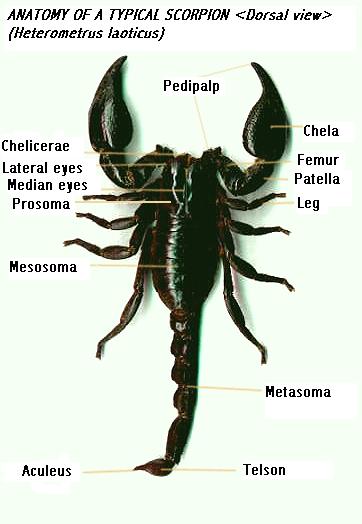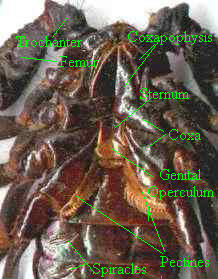
Basic Anatomy of a Scorpion
Knowing at least the basic morphology and anatomy of scorpion forms the basis for further understanding of these unique creatures. No doubt rattling off long terms may sound impressive but constraints of comprehensibility and limited size of my personal page precludes it

The basic external morpholgy of most scorpions includes:
1) 4 pairs of legs
2) 2 pincers known more correctly as pedipalps
3) Chelicera which are the appendages which brings food to
the 'mouth'
4) Prosoma which is the 'head' containing the eyes if present. More
commonly referred to as cephalothorax
5) Opisthosoma which is the abdomen. Contains 7 mesosomal
segments, 5 metasomal segments (tail) and the telson (sting)
6) Pair of pectines .
7) Genital operculum
8) Sternum
9) Metasoma
 |
Heterometrus laoticus with labels of the important parts |
For those who wants to know more
Legs
Till now terminology of the various sections of the appendages is still not
standardised. Generally, the leg is divided into:
coxa (closest to sternum), trochanter, femur, patella, tibia (with tibial spur for some
family), basitarsus (with pedal spur distally for some) and tarsus. It ends with the pair
of ungues (lateral claws) which has apotelle and dactyl (median claws) ventral to it.
Used mainly for locomotry function and may be used to dig substrate and move baby
scorpions (for females)
Pedipalps
The pedipalp is divided into:
coxa, trachanter, femur, patella, tibia and tarsus. The tibia and tarsus forms the chelae
of the pedipalp. The pedipalp contains many hairs (setae). It is divided into 3 types of
which; one type is sensory and named as trichobothria. The arrangement and number of
trichobothria is unique to each genus and is used extensively to identify scorpions. The
trichobothria are erectile and unidirectional in mobilty so that combined information of
differently aligned trichobothria gives a spatial perception of disturbance in air
current.
Used to grasp prey and for defense against predators. Also employed to grasp female chelae
while mating.
Peculiar fact: No abduction muscle for tarsus. The abduction (for opening) of tarsus
is thought to be partially due to increased hydrostatic pressure from dorsoventral
contraction of opisthosoma. It's abduction is now thought to be mainly from the elastic
nature of the fibres in the infolded corium joining the tibia and the tarsus.
Pectens
Also known as the pectines. It is a peculiar gill like structure which some postulated
to be remnants of the ancestral gills of the Silurian water scorpions.. This however has
not been substantiated and pectens apparently is also present in euryterids (ancestral
scorpions). It is found to be of sensory function. In most scorpions, it has
mechano-receptors which is hypothesized to help the male choose suitable substrate for
depositing spermatophore and sense surface vibrations. In some species, it is found to
have some contact chemoreceptors. It is one of the most convenient means of determining
sex. of some species.
Prosoma
Some wonder why the eyes are not included as part of the external morphology. Reason
is simple. In cave dwelling (triglobitic) species like Sotanochactas elliotti ,
eyes are absent. In some other species, there can be up to 6 pairs of eyes! Besides the
central eye group in the picture above, there may be a lateral eye group in the anterior
lateral part of the prosoma. Also note that the chelicera is not its mouth but an
appendages to aid feeding and grasping of food.
Chelicera
Divided into 3 segments: coxa, tibia (fixed finger), tarsus(movable finger). Used to
grasp and crush prey before sucking it. Curiously, it does have an abduction muscle which
is absent in the pedipalp. Pattern and shape is used extensively in differentiating the
families.
Opisthosoma
The ventral carapace(sternite)and the dorsal carapace (tergite)of the mesosoma is
non-continuous while that in the metasoma (tail) is. . They are joined by a whitish
membrane called pleural membrane which would be stretched when the scorpion is very full
or pregnant. The mesosoma is divided into 7 parts while the metasoma which becomes longer
distally has 5 parts.
Sternum
Sternum is the junction where the coxa of most legs meet. The relative length and
shape of the sternum is used extensively to differentiate the families. Pentagonal sternum
is thought by some to be of a more primitive origin. Triangular sternum is
characteristic of buthids which includes some of the more dangerous species.
Genital Operculum
Genital operculum covers the reproductive organs of the scorpions (genital orifice of
females). In the male, the genital operculum is completely separate. A pair of genital
papillae may protrude from the posterior part of the operculum for males of some species.
This may be sclerotised or otherwise but is less evident in some buthids. This is another
key sex dimorphism region.
Metasoma
The metasoma or the so-called 'tail' is divided into 5 true segments. Distal to the
metasoma V is where the telson(sting) is. There are generally 2 venom glands under
voluntary control within the vesicle of the telson. The telson ends with a hypothermic
needle like sting known as aculeus. I re-emphasise that telson is not a true segment and
does not belong to the segments of the opisthosoma. The telson itself is divided into two
parts; the vesicle and the aculeus. In some species they are 'separated' by the subaculeus
tubercle. This, however, is not present in genus Scorpionidae to which Heterometrus
sp. belongs to.